Turtles make wonderful pets for families, animal lovers, and those new to caring for reptiles. While there are many different types of turtles, land-dwelling varieties are often favored for their easier care routines and gentle nature. They are generally low-maintenance and can form meaningful bonds with their humans as well!
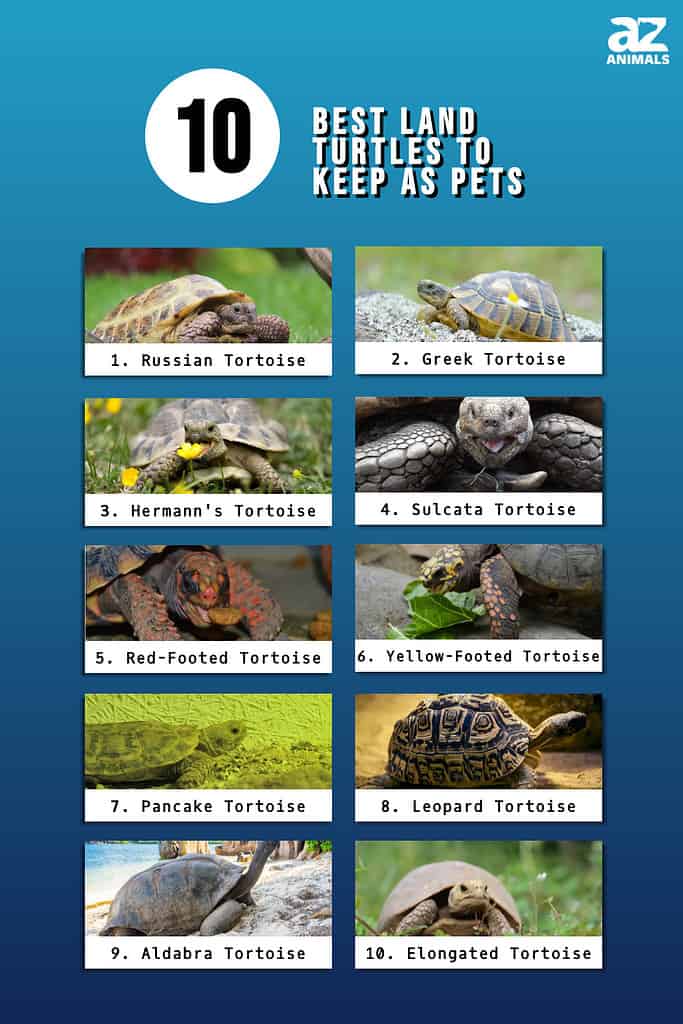
In this article, we’ll explore some of the best types of land turtles, or rather, tortoises, you should consider bringing into your home and keeping them as pets. We’ll focus on their care requirements, personalities, and how well they fit into various living situations. So, get ready to meet your potential new shelled friend!
1. Russian Tortoise (Testudo horsfieldii)

Russian tortoises might be relatively small, but these land turtles can live more than 40 years as pets!
©Haoss/Shutterstock.com
Known for their small stature and charming personalities, Russian tortoises have gained fame as ideal pet companions.
These little creatures can be part of your family for many decades, often living beyond 40 years when well-cared for. With that said, these tortoises do tend to have a longer lifespan in the world, living up to 100 years! Their longevity depends on maintaining a consistent care routine and providing an adequately designed living space.
Adult Russian tortoises typically measure between 5 and 10 inches, with females generally being a tad bit larger than their male counterparts. Their shells are usually a mix of dark green or black, fading to a softer yellow between the segments, and their bodies often have a yellow-brown hue.
Russian Tortoise Care
To keep your Russian tortoise comfortable, it’s crucial to provide a dry and well-ventilated indoor enclosure. This space should offer designated spots for hiding and exercise and feature a substrate that’s easy to clean. Depending on your local weather conditions, they can also be kept outside during warm months. Since their natural habitat is rocky and desert-like, try to mimic this habitat as best you can, with ideal temperatures being between 70 and 90 degrees and a humidity level of less than 70%!
Digging is one of their favorite activities, and it’s not uncommon for these tortoises to vanish underground for a while. Though they’re land dwellers, they’re not very big fans of water, making them different from some other reptiles. Their gentle temperament makes them particularly suitable for families with children.
For their meals, a variety of leafy greens like collard, mustard, and turnip greens, as well as dandelion, watercress, and escarole, are recommended. It’s also okay to occasionally include spinach, kale, and Swiss chard, but these should be limited due to their higher oxalate content.
2. Greek Tortoise (Testudo graeca)
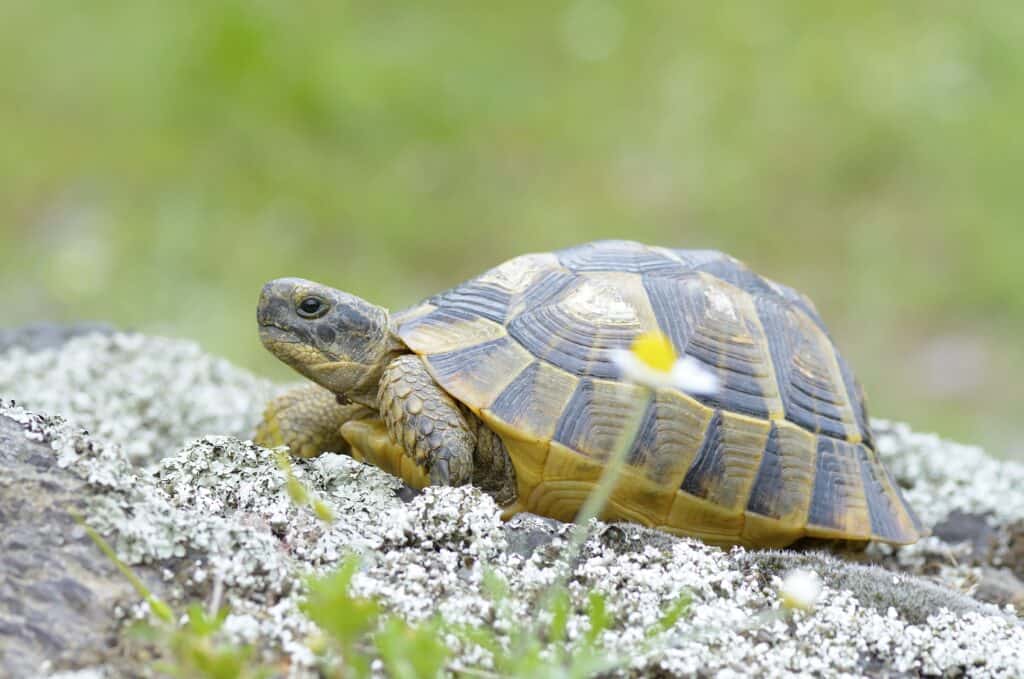
The Greek tortoise can grow up to 10 inches long and come in various colors.
©iStock.com/Remus86
Ideal for both novice and seasoned pet owners, the Greek tortoise is a relatively low-maintenance companion. These tortoises usually grow up to about 8 to 10 inches and display a range of shell colors, from gorgeous brown patternings to shades of golden yellow.
In perfect conditions, they can live more than 50 years! But these reptiles are capable of living well into their 100s as well. Greek tortoises are definitely best for those seeking a lifelong companion.
Friendly and active, these tortoises become accustomed to gentle handling over time. However, younger kids should be supervised when interacting with the tortoise, as these creatures don’t tolerate rough handling well. Try to avoid handling your Greek tortoise if you can, and when you do have to handle it in order to clean its enclosure, make sure to do it slowly and gently.
Greek Tortoise Care
Best kept in outdoor enclosures during the warmer months, Greek tortoises enjoy sunlit spaces that offer plenty of edible plants. Unlike some other reptiles, they are strictly terrestrial and can’t swim. However, they do require water for drinking and maintaining a healthy shell.
Diet-wise, they prefer a high-fiber, low-protein regimen mainly consisting of dark leafy greens and an assortment of vegetables like zucchini, broccoli, and shredded carrots.
Humidity levels in their habitat should be kept between 40% and 60%, which can be monitored using a simple humidity gauge. To maintain this moisture level, you can mist the tortoise every other day or as needed. A constantly filled water dish will also contribute to the right humidity level.
3. Hermann’s Tortoise (Testudo hermanni)
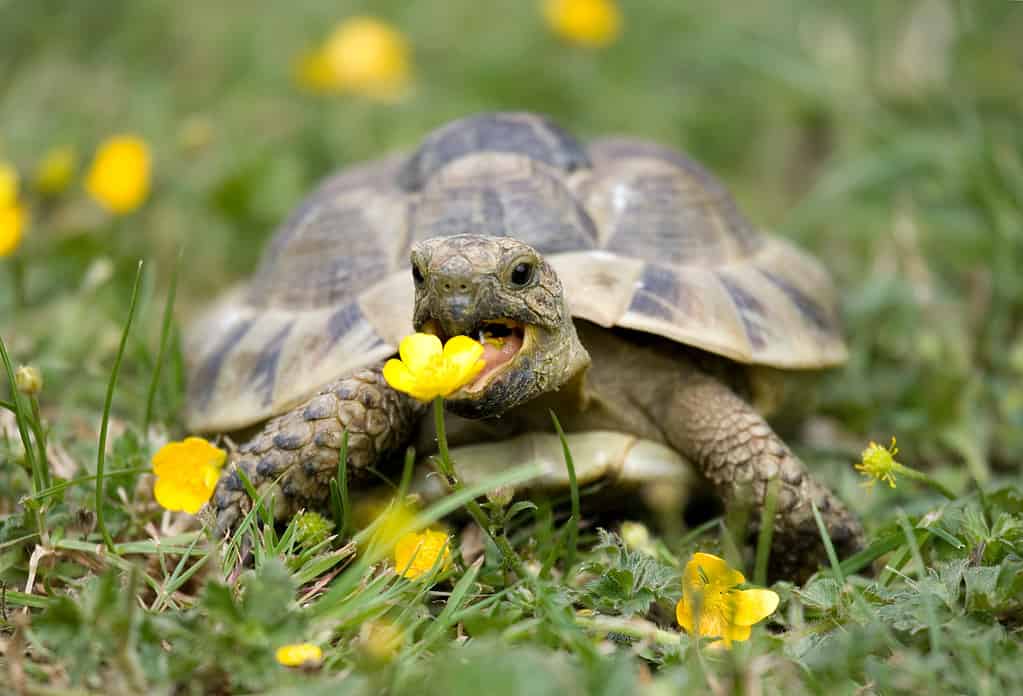
A perfect land turtle to keep as a pet, the Hermann’s tortoise loves to run, dig, and sunbathe.
©chrisbrignell/Shutterstock.com
If you’re looking for a pet tortoise with a long lifespan and specific but manageable care needs, consider the Hermann’s tortoise. These creatures are more comfortable on the ground than in your hands and enjoy a range of activities like running, digging, and sunbathing.
Their shells sport vibrant yellow-orange hues with striking black designs, and their heads typically feature a yellow mark on either side. Most grow to a length of 6 to 8 inches, although some western variants can reach up to 11 inches.
Because these tortoises can easily live for 50 years or more in captivity, keep in mind that owning one is a long-term commitment.
Hermann’s Tortoise Care
It’s best to house them outside, as Hermann’s tortoises don’t do well indoors. The ideal outdoor environment should mimic Mediterranean climates, like those found in Italy and Greece. So, it goes without saying that unless your climate is Mediterranean, it might be better to keep them indoors.
These land turtles love to dig, whether it’s in their enclosure’s substrate or in the great outdoors, especially in soil, sand, or leaf piles. While they are not fond of swimming, they should have access to clean water for drinking at all times.
When it comes to their diet, they primarily eat plant matter. Choices like dandelion, clover, and a variety of leafy greens and vegetables like kale, broccoli, and bell peppers are all appropriate.
4. Sulcata Tortoise (Centrochelys sulcata)
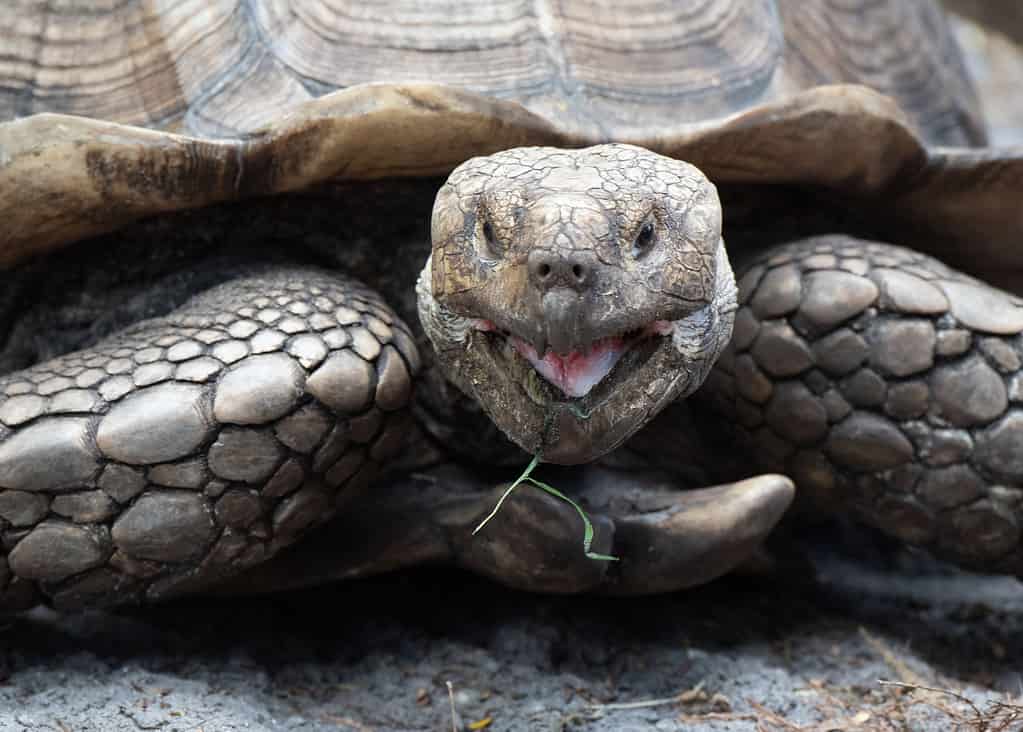
Also called an African spurred tortoise, the Sulcata tortoise is a long-term land turtle pet.
©Dossyl/ via Getty Images
If you live in a warm climate and have a spacious yard, the sociable and easy-going Sulcata tortoise might be the perfect pet for you. These animals are known for their friendly nature and can live for well over 70 years, making them long-term companions.
This tortoise features a shell that ranges in color from brown to yellow and is complemented by its thick, yellow-brown skin. Additionally, its legs are adorned with pointed scales, commonly referred to as spurs. These spurs give these land turtles their other common name: African spurred tortoise.
In terms of size, they’re definitely on the larger end of the scale. Adult Sulcatas usually measure around 18 inches across their shells and can weigh between 70 to 100 pounds. Some even grow to be two to three feet long, weighing over 150 pounds! So, before you commit to one, make sure you have the space.
Sulcata Tortoise Care
Sulcata tortoises can live up to 50 years in a domestic setting and are often recommended for beginners due to their interactive and intelligent behavior. However, because they like to dig, a strong, deep fence around their outdoor enclosure is essential.
When it comes to food, the Sulcata tortoise is a consistent grazer. Their diet should mainly consist of fresh grass and hay. Occasional treats like mulberry leaves and hibiscus flowers are okay, but fruits and vegetables should be given sparingly to maintain a low-protein diet.
To keep them healthy, it’s important to maintain a dry living environment. Ensure their area is free from dampness and excess water. Despite their need for dry conditions, a shallow bowl of water should always be accessible, especially if there’s no mud puddle in their outdoor space.
5. Red-Footed Tortoise (Chelonoidis carbonaria)
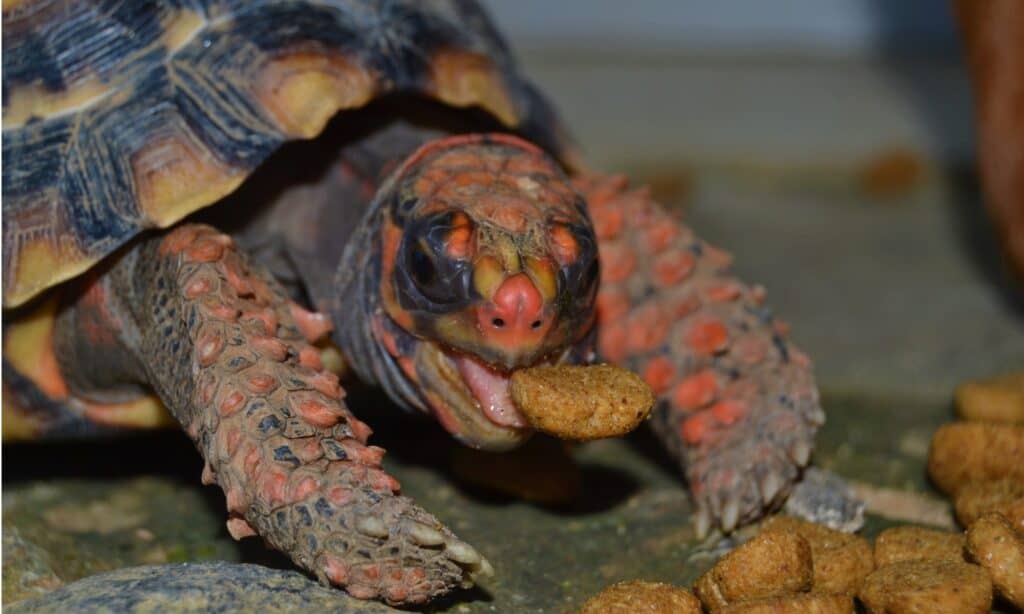
As evidenced by its name, the red-footed tortoise boasts red markings.
©iStock.com/Markus Frenzel
Red-footed tortoises stand out as a top land turtle pick for pet owners due to their easy-going nature, low maintenance, and stunning looks. These tortoises boast textured shells in shades ranging from black and gray to brown. Juveniles have unique tan or yellow spots, and many sport vibrant red markings on their heads.
In terms of size, males usually outgrow females, with some reaching up to 14 inches long. While they have a lifespan of 20 to 40 years in their natural habitat, they often live considerably longer in captivity — up to 90 years is not uncommon! But on average, a captive red-footed tortoise will have a lifespan of 50 to 90 years.
Red-Footed Tortoise Care
For housing, they are best suited to outdoor enclosures that are both secure and hard to escape from. Red-footed tortoises thrive in humid conditions similar to their tropical origins. To maintain the right humidity, consider installing a mister or sprinkler system. These tortoises also enjoy having access to muddy areas for cooling down.
The outdoor enclosure should have strong walls that are at least 16 inches high and sunk a few inches into the ground. Unlike some other tortoises, red-footed tortoises are not big on digging, making containment a bit easier.
A balanced meal for an adult includes a mix of veggies, fruits, and leaves. Recommended greens are mulberry leaves, hibiscus, and grape leaves. A rotation of various colorful lettuces is also beneficial. For a fruity treat, consider adding apples, bananas, melons, plums, or tomatoes to their diet.
6. Yellow-Footed Tortoise (Chelonoidis denticulata)

Living for 50 to 60 years, the yellow-footed tortoise is a rewarding land turtle pet.
©guentermanaus/Shutterstock.com
Yellow-footed tortoises are rewarding pets, sharing many similarities with their red-footed cousins, such as long lifespans and eye-catching features. These tortoises have black shells adorned with unique yellow designs around each plate. Their legs and head may also sport patches of red, yellow, or orange, giving them a colorful appearance. These land turtles can reach an average size of 16 inches, but some can grow much larger!
Expect these reptiles to live for 50 to 60 years!
Yellow-Footed Tortoise Care
These tortoises have specific housing needs. They prefer more stable temperatures and greater shade than their red-footed relatives. While young tortoises can comfortably reside in smaller spaces like tables or tubs designed for tortoises, a full-grown adult will require a larger area, no less than 8 feet by 4 feet.
Diet-wise, they’re not strictly herbivores; they enjoy a more varied diet. Along with leafy greens such as dandelions and chicory, they appreciate fruits like berries and melons. They’re actually more inclined toward fruit than red-footed tortoises, often enjoying papayas, plums, and peaches.
To keep them comfortable, a large outdoor space is recommended, which should be humid and warm to mimic their Amazonian home. A water feature for soaking is also essential for their well-being. Try to keep the humidity around 80%.
7. Pancake Tortoise (Malacochersus tornieri)

Interestingly, pancake tortoises have a flat, pancake-like shell.
©Millie Bond – Copyright A-Z Animals
Pancake tortoises have a unique flat shell, making them easier to handle and ideal for pet owners with less space. Well-cared-for individuals can live for up to 35 years or more, so they’re a long-term pet commitment.
Their shells have varied brown shades with patterns that help them blend into rocky environments. They also sport a light yellow underbelly, while their head, limbs, and tail typically share a yellow-brown hue. These tortoises generally grow to a length of about 7 inches.
Pancake Tortoise Care
Suitable for outdoor living in mild climates during the warmer months, they need indoor accommodations during the colder seasons, as they don’t hibernate. Unlike many of their kind, these tortoises are more likely to flee than hide when startled.
For a pair, you’ll need at least a 4-square-foot enclosure. For each additional tortoise, add another 2 square feet. The enclosure walls should be at least one foot high but even higher for mature tortoises to prevent them from climbing out.
In terms of diet, they’re plant eaters who favor high-fiber grasses and weeds over leafy vegetables. Younger pancake tortoises should be allowed to eat as much as they want daily to support their growth.
8. Leopard Tortoise (Stigmochelys pardalis)
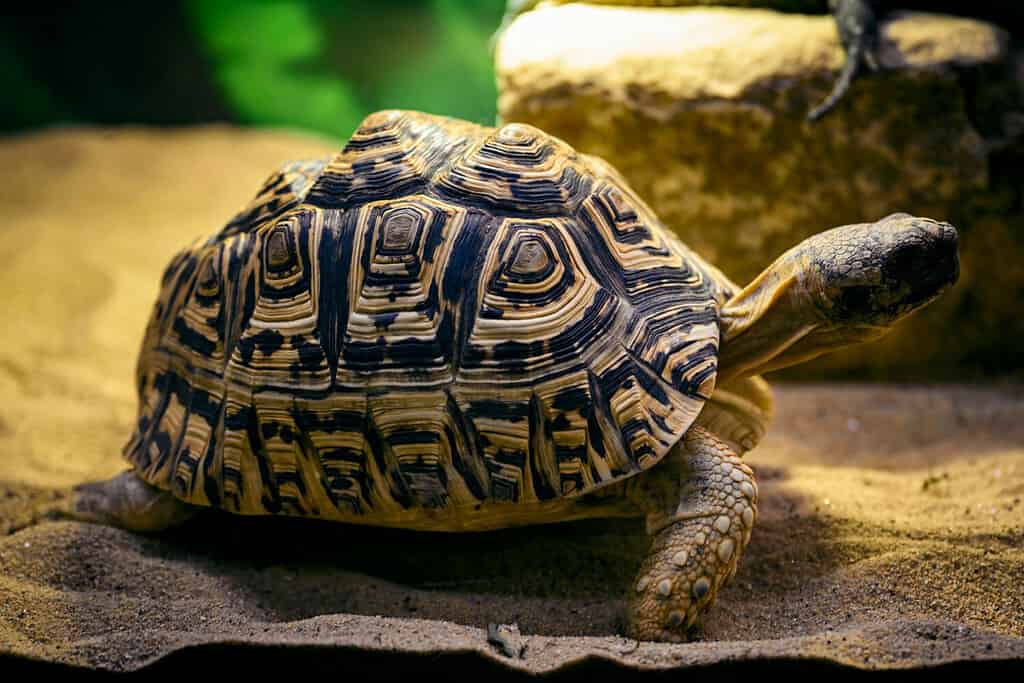
A beautiful land turtle to keep as a pet, the
leopard
tortoise is generally friendly.
©Lapis2380/Shutterstock.com
Leopard tortoises are generally friendly and less likely to nip at human fingers, though, like other land turtles, they’re still not big fans of being handled often. These tortoises are among the world’s largest tortoises, and their shells have a striking pattern that resembles leopard spots, featuring circles of yellow, tan, and brown. Fully grown, they can measure up to two feet and weigh as much as 80 pounds.
In terms of lifespan, they can live for about half a century in their natural dry habitats but tend to live longer — around 75 years — when kept in a controlled environment.
Leopard Tortoise Care
For keeping leopard tortoises indoors, it’s crucial to provide both dry and moist zones in their living space. A single adult needs ample room to roam — no less than 50 square feet.
Their diet mainly consists of grazing on available plants. They particularly enjoy eating the pads of prickly pear cacti, as well as leaves from mulberry and hibiscus plants. Various other decorative plants are also safe for them to consume.
As these tortoises are used to warm climates, they can’t tolerate cold weather. It’s best to let them spend as much time as possible in a secure outdoor enclosure that receives plenty of sunlight. Just make sure to include a sheltered spot where the tortoise can retreat for some shade.
9. Aldabra Tortoise (Aldabrachelys gigantea)
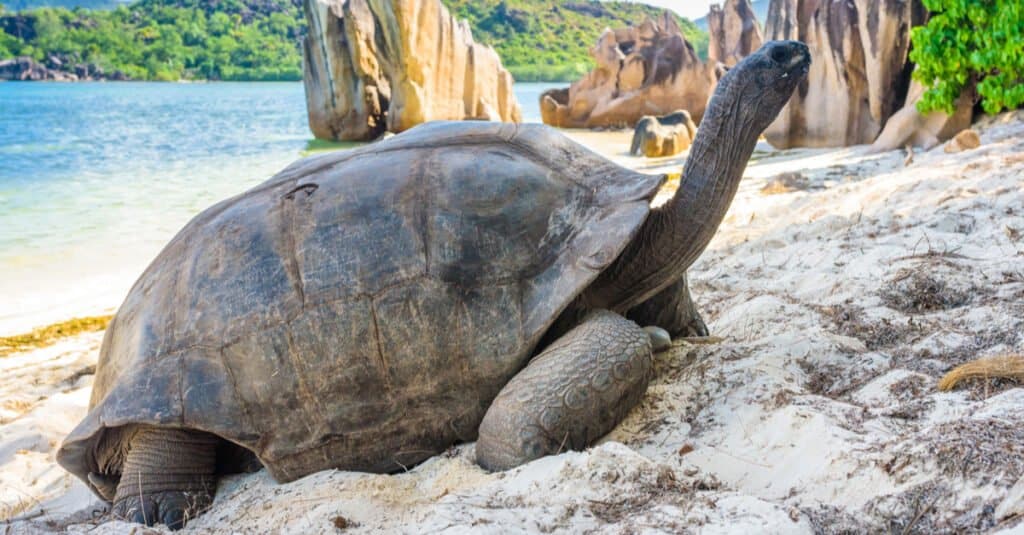
If you’re looking for a giant tortoise, the Aldabra is a good pick for a pet.
©Jan Bures/Shutterstock.com
Aldabra tortoises are fulfilling companions if you have ample space and time to meet their requirements. Given their long lifespans, you’ll likely need to plan for their care well into the future, as they may outlive you. They are intelligent, engaging, and offer endless entertainment.
Distinct from other giant tortoises, Aldabras have a unique small plate near their necks on their upper shell. Males also have a bowl-shaped lower shell that helps during mating. These tortoises sport a dark gray or black color and have an upper shell that’s notably thick and dome-shaped.
When it comes to size, Aldabras are some of the heaviest land tortoises around. Males are generally heftier than females and have more robust, extended tails. A male can have an upper shell measuring up to four feet and can tip the scales at an impressive 550 pounds.
These tortoises can live for a very long time, generally ranging from 80 to 150 years. One recorded male even reached an astonishing 255 years before passing away.
Aldabra Tortoise Care
As pets, Aldabra giant tortoises need a large area to move about freely. Enclosures should have walls slightly above two feet in height, and the ground space should cover at least a 30-by-30-foot area.
Diet-wise, they mainly feed on plant matter. In natural settings, they munch on grass, leaves, and various plants. Although they can eat insects and carrion, their primary diet in captivity consists of grass, leafy vegetables, flowers, and even specially-made tortoise food.
Although they can handle cooler temperatures better than some other tortoises, Aldabras still need additional heat sources to maintain an ideal temperature range of 75 to 100 degrees Fahrenheit.
10. Elongated Tortoise (Indotestudo elongata)
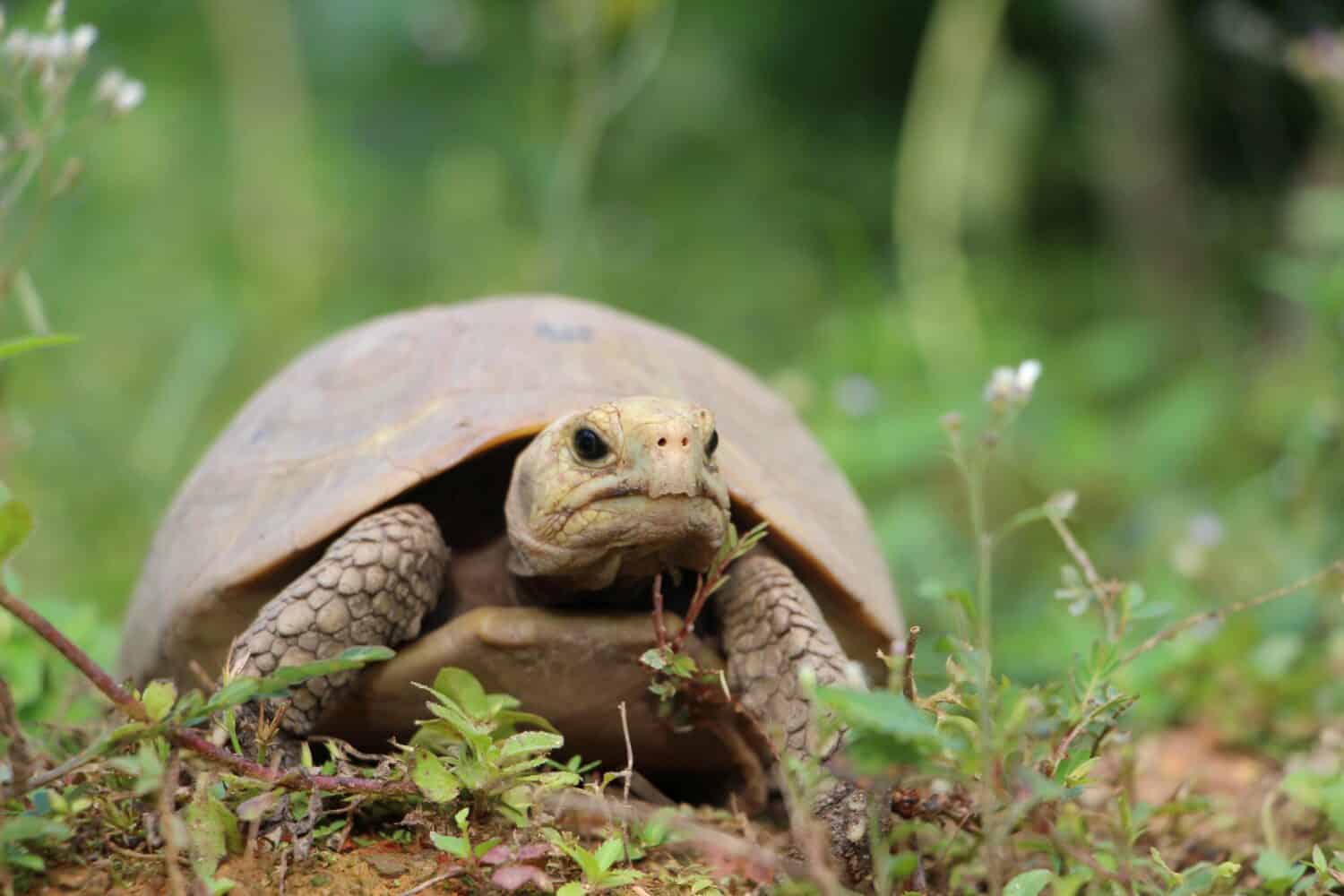
Moderate in size, elongated tortoises are originally from Asia.
©seasoning_17/Shutterstock.com
Elongated tortoises make wonderful pets if you can maintain the warm and humid conditions they need year-round. They’re moderate in size, reaching lengths of 12 to 14 inches, and are known for their long lifespan. These tortoises typically live for 40 to 50 years. Since this tortoise species is neither too big nor aggressive, it is an ideal choice for pet owners.
They have elongated, somewhat slim shells that are a shade of yellow-brown, usually featuring dark markings on each shell segment. The males have a slight inward curve on the lower shell and longer tails compared to females.
Elongated Tortoise Care
Originally from the warm forests of Asia, elongated tortoises love to spend their time hidden under leaves or near large plants. If you’re keeping them as pets, an outdoor pen with plenty of hiding spots works well. For a pair of adult elongated tortoises, you’ll need a space at least 4 by 8 feet and 1 to 2 feet tall.
In terms of food, these tortoises mainly eat an assortment of veggies and edible leaves, but they also eat meat, snails, and eggs to round out their diet. Just feeding them vegetables won’t give them all the nutrients they need.
Keep in mind that because these tortoises come from tropical regions, they can’t handle cold weather and must be moved indoors over the winter.
Summary of the Best Land Turtles to Keep as Pets
| Number | Land Turtle | Scientific Name |
|---|---|---|
| 1. | Russian Tortoise | Testudo horsfieldii |
| 2. | Greek Tortoise | Testudo graeca |
| 3. | Hermann’s Tortoise | Testudo hermanni |
| 4. | Sulcata Tortoise | Centrochelys sulcata |
| 5. | Red-Footed Tortoise | Chelonoidis carbonaria |
| 6. | Yellow-Footed Tortoise | Chelonoidis denticulata |
| 7. | Pancake Tortoise | Malacochersus tornieri |
| 8. | Leopard Tortoise | Stigmochelys pardalis |
| 9. | Aldabra Tortoise | Aldabrachelys gigantea |
| 10. | Elongated Tortoise | Indotestudo elongata |
The photo featured at the top of this post is © guentermanaus/Shutterstock.com
Thank you for reading! Have some feedback for us? Contact the AZ Animals editorial team.






